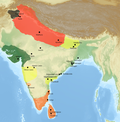The Mahāsāṃghika (Brahmi: 𑀫𑀳𑀸𑀲𑀸𑀁𑀖𑀺𑀓, "of the Great Sangha", Chinese: 大眾部; pinyin: Dà zhòng bù) was a major division (nikāya) of the early Buddhist...
61 KB (7,630 words) - 02:50, 9 August 2024
Buddhahood (section Mahāsāṃghika school)
schools, the Mahāsāṃghika branch regarded the buddhas as being characterized primarily by their supramundane (lokottara) nature. The Mahāsāṃghikas advocated...
69 KB (7,031 words) - 14:35, 17 August 2024
Tripiṭaka (section Mahāsāṃghika)
accepted as canonical by the Mahāsāṃghika school. The Theravādin Dīpavaṃsa, for example, records that the Mahāsāṃghikas had no abhidharma. However, other...
34 KB (3,391 words) - 12:21, 1 August 2024
existed in the early Buddhist schools. The Sarvāstivāda, Kāśyapīya, Mahāsāṃghika, Ekavyāvahārika, Lokottaravāda, Bahuśrutīya, Prajñaptivāda, and Caitika...
28 KB (3,366 words) - 19:59, 8 August 2024
the first early schools (generally believed to be the Sthavira and the Mahāsāṃghika) during or after the reign of Aśoka. Later, these first early sects were...
44 KB (4,664 words) - 12:15, 29 July 2024
Devadatta (section Mahāsāṃghika Vinaya research)
generally agrees that the Mahāsāṃghika Vinaya is the oldest extant Buddhist Vinaya. According to Reginald Ray, the Mahāsāṃghika Vinaya mentions the figure...
18 KB (2,231 words) - 15:38, 21 June 2024
Buddhism suggests that Mahāsāṃghikas tried to change the traditional Vinaya by adding the above ten points to it. However, Mahāsāṃghikas hold that the Sthaviras...
47 KB (5,817 words) - 01:51, 14 May 2024
was one of the early Buddhist schools. They split from the majority Mahāsāṃghikas at the time of the Second Buddhist council. The Sthavira nikāya was...
8 KB (918 words) - 12:25, 14 March 2024
Ekavyāvahārika (category Mahāsāṃghika)
the early Buddhist schools, and is thought to have separated from the Mahāsāṃghika sect during the reign of Aśoka. Tāranātha viewed the Ekavyāvahārikas...
5 KB (683 words) - 22:58, 22 April 2021
Nikaya Buddhism (section In the Mahāsāṃghika branch)
the Mahāsāṃghikas, the bodhisattva ideal and buddhahood was advocated over the ideal of becoming an arhat. Avalokitavrata wrote of the Mahāsāṃghikas as...
10 KB (1,224 words) - 11:37, 30 April 2024
Early Buddhist texts (section Mahāsāṃghika sources)
sources. However, fewer Mahāsāṃghika texts have survived in comparison to Sthavira material. One important source for Mahāsāṃghika EBTs is the Mahāvastu...
47 KB (5,781 words) - 06:04, 7 May 2024
Svasaṃvedana (section Mahasamghika school)
of consciousness. It was initially a theory of cognition held by the Mahasamghika and Sautrantika schools while the Sarvastivada-Vaibhasika school argued...
11 KB (1,460 words) - 06:08, 15 June 2024
accepted as canonical by the Mahāsāṃghika school. The Theravādin Dīpavaṃsa, for example, records that the Mahāsāṃghikas had no abhidharma. However, other...
79 KB (9,945 words) - 17:00, 27 June 2024
all of these doctrines are shared by the Theravada Pali texts and the Mahasamghika school's Śālistamba Sūtra. A recent study by Bhikkhu Analayo concludes...
245 KB (27,308 words) - 23:59, 18 August 2024
Caitika (category Mahāsāṃghika)
(Chinese: 制多山部 or 制多部) was an early Buddhist school, a sub-sect of the Mahāsāṃghika. They were also known as the Caityaka sect. The Caitikas proliferated...
13 KB (1,582 words) - 18:38, 1 November 2022
One of the few Mahāsāṃghika texts which survive, the Mahāvastu, is from this school. Another sub-sect which emerged from the Mahāsāṃghika was called the...
42 KB (4,276 words) - 07:35, 12 August 2024
Zhihua Yao and Tse Fu Kuan consider the Ekottara Āgama to belong to the Mahāsāṃghika school. According to A.K. Warder, the Ekottara Āgama references 250 Prātimokṣa...
11 KB (1,048 words) - 21:10, 22 May 2024
monasticism and asceticism. The Mahāsāṃghika origin theory, which argues that Mahāyāna developed within the Mahāsāṃghika tradition. This is defended by...
145 KB (17,105 words) - 19:19, 17 July 2024
Nirvana (Buddhism) (section Mahāsāṃghika)
that is absolute truth which is Nirvana. According to Andre Bareau, the Mahāsāṃghika school held that the nirvana reached by arhats was fundamentally inferior...
147 KB (18,098 words) - 12:24, 17 August 2024
outflows. In many other ways, their views are similar to those of the Mahāsāṃghikas. According to the Abhidharma Mahāvibhāṣā Śāstra, the Dharmaguptakas...
28 KB (3,385 words) - 06:13, 8 November 2023
Luminous mind (section Mahāsāṃghika)
nothing of his entire body unpervaded by pure, bright awareness. The Mahāsāṃghikas also held that the mind’s nature (cittasvabhāva) is fundamentally pure...
31 KB (3,981 words) - 14:23, 14 August 2024
Kukkuṭika (category Mahāsāṃghika)
pinyin: Jīyìn Bù) were an early Buddhist school which descended from the Mahāsāṃghika. It is likely that the name Kukkuṭika or Kukkulika originated from the...
5 KB (679 words) - 01:50, 31 August 2022
Emperor Ashoka, the Buddhist community split into two branches: the Mahāsāṃghika and the Sthaviravāda, each of which spread throughout India and split...
85 KB (9,263 words) - 07:08, 14 August 2024
in Asian canonical manuscripts, including those of the Kāśyapīya, the Mahāsāṃghika, the Mahīśāsaka, the Sammatīya, and the Sarvāstivāda. The word Vinaya...
26 KB (2,987 words) - 12:07, 25 March 2024
traditions or Nikaya schools, including Theravāda, Sarvāstivāda and Mahāsāṃghika. The doctrine is found, for example, in 2nd century CE sources like the...
107 KB (12,416 words) - 01:21, 6 August 2024
reasonably good Sanskrit, sometimes with a Pali syntax, states Renou. The Mahāsāṃghika and Mahavastu, in their late Hinayana forms, used hybrid Sanskrit for...
307 KB (32,164 words) - 19:31, 18 August 2024
Dharmakāya (section Mahāsāṃghika)
According to Guang Xing, two main aspects of the Buddha can be seen in Mahāsāṃghika teachings: the true Buddha who is omniscient and omnipotent, and the...
26 KB (3,131 words) - 11:30, 17 August 2024
Prajñaptivāda (category Mahāsāṃghika)
traditional Chinese: 說假部; ; pinyin: Shuō Jiǎ Bù) was a branch of the Mahāsāṃghika, one of the early Buddhist schools in India. The Prajñaptivādins were...
7 KB (849 words) - 02:48, 14 April 2023
prātimokṣa codes are extant, including those contained in the Theravāda, Mahāsāṃghika, Mahīśāsaka, Dharmaguptaka, Sarvāstivāda and Mūlasarvāstivāda vinayas...
7 KB (874 words) - 14:46, 30 March 2024
Buddhism. It also does not include other Indian Buddhist schools, such as Mahasamghika and Pudgalavada.[citation needed] Two tenets belong to the path referred...
133 KB (15,316 words) - 09:06, 15 August 2024
















